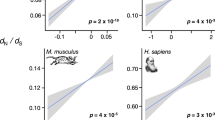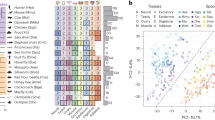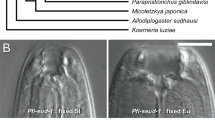Abstract
Evolutionary theory assumes that genetic variation is uniform and gradual in nature, yet morphological and gene expression studies have revealed that different life-stages exhibit distinct levels of cross-species conservation. In particular, a stage in mid-embryogenesis is highly conserved across species of the same phylum, suggesting that this stage is subject to developmental constraints, either by increased purifying selection or by a strong mutational bias. An alternative explanation, however, holds that the same ‘hourglass’ pattern of variation may result from increased positive selection at the earlier and later stages of development. To distinguish between these scenarios, we examined gene expression variation in a population of the nematode Caenorhabditis elegans using an experimental design that eliminated the influence of positive selection. By measuring gene expression for all genes throughout development in 20 strains, we found that variations were highly uneven throughout development, with a significant depletion during mid-embryogenesis. In particular, the family of homeodomain transcription factors, whose expression generally coincides with mid-embryogenesis, evolved under high constraint. Our data further show that genes responsible for the integration of germ layers during morphogenesis are the most constrained class of genes. Together, these results provide strong evidence for developmental constraints as the mechanism underlying the hourglass model of animal evolution. Understanding the pattern and mechanism of developmental constraints provides a framework to understand how evolutionary processes have interacted with embryogenesis and led to the diversity of animal life on Earth.
This is a preview of subscription content, access via your institution
Access options
Access Nature and 54 other Nature Portfolio journals
Get Nature+, our best-value online-access subscription
$29.99 / 30 days
cancel any time
Subscribe to this journal
Receive 12 digital issues and online access to articles
$119.00 per year
only $9.92 per issue
Buy this article
- Purchase on Springer Link
- Instant access to full article PDF
Prices may be subject to local taxes which are calculated during checkout




Similar content being viewed by others
References
Arthur, W. Evolution: A Developmental Approach (Wiley, 2010).
Gerhart, J. & Kirschner, M. Cells, Embryos and Evolution (Wiley, 1997).
Carroll, S. B., Grenier, J. K. & Weatherbee, S. D. From DNA to Diversity: Molecular Genetics and the Evolution of Animal Design (Wiley, 2004).
Davidson, E. H. & Erwin, D. H. Gene regulatory networks and the evolution of animal body plans. Science 311, 796–800 (2006).
Wallace, A. R. Contributions to the Theory of Natural Selection. A Series of Essays (Macmillan, 1870).
Mayr, E. Animal Species and Evolution (Belknap/Harvard Univ. Press, 1963).
Arthur, W. The interaction between developmental bias and natural selection: from centipede segments to a general hypothesis. Heredity 89, 239–246 (2002).
Hall, B. K. Evolutionary Developmental Biology (Springer Science & Business Media, 1998).
Smith, J. M. et al. Developmental constraints and evolution: a perspective from the Mountain Lake Conference on Development and Evolution. Q. Rev. Biol. 60, 265–287 (1985).
von Baer, K. E. Über Entwickelungsgeschichte der Thiere. Beobachtung und Reflexion (Bornträger, 1828).
Haeckel, E. H. P. A. Anthropogenie; oder, Entwickelungsgeschichte des Menschen... Keimes- und Stammes-geschichte (Leipzig, 1874).
Sander, K. Pattern specification in the insect embryo. Ciba Foundation Symposium 29: Cell Patterning (eds Porter, R. & Rivers, J. ) 241–263 (Wiley, 1975).
Goldstein, B., Frisse, L. M. & Thomas, W. K. Embryonic axis specification in nematodes: evolution of the first step in development. Curr. Biol. 8, 157–160 (1998).
Irmler, I., Schmidt, K. & Starck, J. M. Developmental variability during early embryonic development of zebra fish, Danio rerio. J. Exp. Zool. B 302, 446–457 (2004).
Duboule, D. Temporal colinearity and the phylotypic progression: a basis for the stability of a vertebrate Bauplan and the evolution of morphologies through heterochrony. Dev. Suppl. 135–142 (1994).
Slack, J. M., Holland, P. W. & Graham, C. F. The zootype and the phylotypic stage. Nature 361, 490–492 (1993).
Raff, R. A. The Shape of Life: Genes, Development, and the Evolution of Animal Form (Univ. Chicago Press, 2012).
Kalinka, A. T. et al. Gene expression divergence recapitulates the developmental hourglass model. Nature 468, 811–814 (2010).
Levin, M., Hashimshony, T., Wagner, F. & Yanai, I. Developmental milestones punctuate gene expression in the Caenorhabditis embryo. Dev. Cell 22, 1101–1108 (2012).
Hazkani-Covo, E., Wool, D. & Graur, D. In search of the vertebrate phylotypic stage: a molecular examination of the developmental hourglass model and von Baer's third law. J. Exp. Zool. B 304, 150–158 (2005).
Irie, N. & Kuratani, S. Comparative transcriptome analysis reveals vertebrate phylotypic period during organogenesis. Nat. Commun. 2, 248 (2011).
Domazet-Lošo, T. & Tautz, D. A phylogenetically based transcriptome age index mirrors ontogenetic divergence patterns. Nature 468, 815–818 (2010).
Quint, M. et al. A transcriptomic hourglass in plant embryogenesis. Nature 490, 98–101 (2012).
Drost, H. -G., Gabel, A., Grosse, I. & Quint, M. Evidence for active maintenance of phylotranscriptomic hourglass patterns in animal and plant embryogenesis. Mol. Biol. Evol. 32, 1221–1231 (2015).
Cheng, X., Hui, J. H. L., Lee, Y. Y., Wan Law, P. T. & Kwan, H. S. A ‘developmental hourglass’ in fungi. Mol. Biol. Evol. 32, 1556–1566 (2015).
Harding, K., Wedeen, C., McGinnis, W. & Levine, M. Spatially regulated expression of homeotic genes in Drosophila. Science 229, 1236–1242 (1985).
Akam, M. The molecular basis for metameric pattern in the Drosophila embryo. Development 101, 1–22 (1987).
Schmidt, K. & Starck, J. M. Testing evolutionary hypotheses about the phylotypic period of zebrafish. J. Exp. Zool. B 316, 319–329 (2011).
Rebeiz, M., Jikomes, N., Kassner, V. A. & Carroll, S. B. Evolutionary origin of a novel gene expression pattern through co-option of the latent activities of existing regulatory sequences. Proc. Natl Acad. Sci. USA 108, 10036–10043 (2011).
Halligan, D. L. & Keightley, P. D. Spontaneous mutation accumulation studies in evolutionary genetics. Annu. Rev. Ecol. Evol. System. 40, 151–172 (2009).
Baer, C. F. et al. Comparative evolutionary genetics of spontaneous mutations affecting fitness in rhabditid nematodes. Proc. Natl Acad. Sci. USA 102, 5785–5790 (2005).
Levin, M. et al. The mid-developmental transition and the evolution of animal body plans. Nature 531, 637–641 (2016).
Hashimshony, T., Feder, M., Levin, M., Hall, B. K. & Yanai, I. Spatiotemporal transcriptomics reveals the evolutionary history of the endoderm germ layer. Nature 519, 219–222 (2015).
Stoltzfus, A. & Yampolsky, L. Y. Climbing Mount Probable: mutation as a cause of nonrandomness in evolution. J. Hered. 100, 637–647 (2009).
Gilbert, S. F. Developmental Biology 6th edn (Sinauer, 2000).
Yanai, I., Peshkin, L., Jorgensen, P. & Kirschner, M. W. Mapping gene expression in two Xenopus species: evolutionary constraints and developmental flexibility. Dev. Cell 20, 483–496 (2011).
Gerstein, M. B. et al. Comparative analysis of the transcriptome across distant species. Nature 512, 445–448 (2014).
Estes, S. & Lynch, M. Rapid fitness recovery in mutationally degraded lines of Caenorhabditis elegans. Evolution 57, 1022–1030 (2003).
Baugh, L. R., Hill, A. A., Slonim, D. K., Brown, E. L. & Hunter, C. P. Composition and dynamics of the Caenorhabditis elegans early embryonic transcriptome. Development 130, 889–900 (2003).
Baker, S. C. et al. The External RNA Controls Consortium: a progress report. Nat. Methods 2, 731–734 (2005).
Hashimshony, T., Wagner, F., Sher, N. & Yanai, I. CEL-Seq: single-cell RNA-Seq by multiplexed linear amplification. Cell Rep. 2, 666–673 (2012).
Hashimshony, T. et al. CEL-Seq2: sensitive highly-multiplexed single-cell RNA-Seq. Genome Biol. 17, 77 (2016).
Langmead, B., Trapnell, C., Pop, M. & Salzberg, S. L. Ultrafast and memory-efficient alignment of short DNA sequences to the human genome. Genome Biol. 10, R25 (2009).
Anders, S., Pyl, P. T. & Huber, W. HTSeq — a Python framework to work with high-throughput sequencing data. Bioinformatics 31, 166–169 (2015).
Howe, K. L. et al. WormBase 2016: expanding to enable helminth genomic research. Nucl. Acids Res. 44, D774–D780 (2016).
Acknowledgements
We thank C. F. Baer of the University of Florida at Gainesville for providing the mutation accumulation strains and for his comments. We thank J. F. Ryan from the Whitney Institute for Marine Bioscience for comments. We also thank members of our laboratory for constructive comments. We thank the Technion Genome Center for technical assistance.
Author information
Authors and Affiliations
Contributions
H.Z. and I.Y. conceived and designed the project. H.Z. led the collection of samples, the processing of the samples for CEL-Seq and the initial bioinformatics. Both authors analysed the data and wrote the manuscript.
Corresponding author
Ethics declarations
Competing interests
The authors declare no competing financial interests.
Supplementary information
Supplementary Information
Supplementary Figures 1–4; Supplementary Table 1. (PDF 3985 kb)
Rights and permissions
About this article
Cite this article
Zalts, H., Yanai, I. Developmental constraints shape the evolution of the nematode mid-developmental transition. Nat Ecol Evol 1, 0113 (2017). https://doi.org/10.1038/s41559-017-0113
Received:
Accepted:
Published:
DOI: https://doi.org/10.1038/s41559-017-0113
This article is cited by
-
Transcription–replication interactions reveal bacterial genome regulation
Nature (2024)
-
Stability in gene expression and body-plan development leads to evolutionary conservation
EvoDevo (2023)
-
Conceptual and empirical bridges between micro- and macroevolution
Nature Ecology & Evolution (2023)
-
Potential contribution of intrinsic developmental stability toward body plan conservation
BMC Biology (2022)
-
Analysis of the leaf metabolome in Arabidopsis thaliana mutation accumulation lines reveals association of metabolic disruption and fitness consequence
Evolutionary Ecology (2022)



